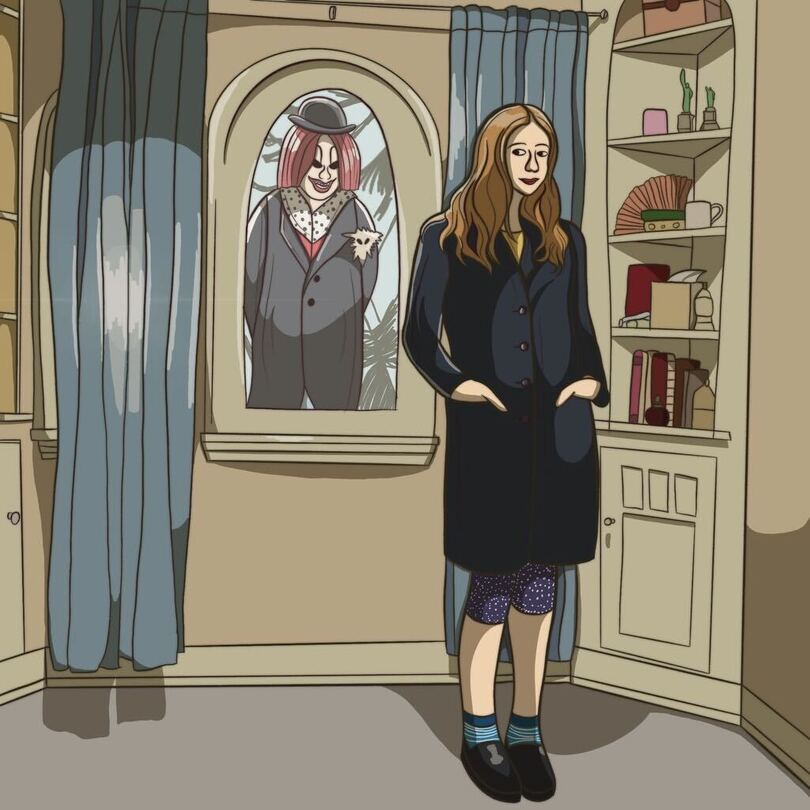Audrey Hobert is unashamedly weird in ‘Who’s The Clown?’ debut

Pop fans might find the lyrical style of Audrey Hobert’s debut album familiar after falling in love with Gracie Abrams’ “That’s So True,” which Hobert collaborated on. The artist expands on the catchy style in a 12-song album. Maria Masek | Contributing Illustrator
Get the latest Syracuse news delivered right to your inbox.
Subscribe to our newsletter here.
When Gracie Abrams’ “That’s So True” released last fall, it took the pop music world by storm. The single was lauded for its catchy bridge and peaked at No. 6 on the Billboard Hot 100 charts.
But what made this song so infectious, especially compared to a number of Abrams’ other hits? The answer might be Abrams’ close friend and “That’s So True” co-writer, Audrey Hobert.
After collecting several credits as a writer and composer for Abrams, Hobert released her debut album, “Who’s The Clown?” on Aug. 15. The 12-track record uses a classic pop production to tell impressively candid stories about Hobert’s personhood and struggles as a young adult.
The album starts with “I like to touch people” a comedically-named song about excessive people pleasing. It’s the perfect start to this unapologetically weird album.
Hobert portrays herself as an observer who finds joy in making others laugh and feel seen, even though she couldn’t care less about the content of the interaction.
“Sue Me” is the album’s debut single that wormed its way into many ears since its release on May 9. The song’s concept is simple and can be summed up in a single line that repeats over and over: “Sue me, I wanna be wanted.”
In the song, Hobert is transparent about her willingness to entertain an ex if it means being desired by someone. With over 25 million Spotify streams since its release and TikTok virality, it’s clear this song quickly resonated with the right audience.
“Wet Hair,” “Bowling alley” and “Thirst Trap,” really show the audience who Audrey Hobert is as an artist and person. Listening to “Bowling alley” and “Wet Hair” feels like a stream of messy consciousness. It jumps from thought to thought as she navigates situations like reconnecting with an ex or going to a party she doesn’t want to attend.
In “Wet Hair,” Hobert wants her ex to think she’s carefree, so she shows up to the bar with wet hair. Despite her intentions in the real world, we hear her thought process in the song as she analyzes every action she takes. It’s clear she cares, maybe even too much.
We see this transcend past romantic relationships in “Bowling alley,” a song Hobert regards as one of her favorite songs she’s ever written.
Hobert explained that the song captures the anxieties of being unwanted at a party even when you were invited. She also touches on the frustration of only feeling noticed by acquaintances after doing something in the public eye.
Walking through her night out, we hear Hobert narrate every thought she has. In the song, it seems like every action she takes is the wrong one. She only prays in a crisis, but “it’s a crisis nightly now,” she sings. The track is a complicated vocalization of the anxious feelings that young people can identify with.
Next comes “Thirst Trap,” a song about a deep, and somewhat obsessive, desire to be deemed attractive by a crush. This isn’t the end goal, but rather a stepping stone to being truly desired. Many of the other songs on the album toy with this idea.
Although the entire album is very candid, Hobert dives deeper into her insecurities with “Sex and the city.” The song is a slower acoustic ballad that compares the artist’s life to that of “Sex and the City” main character Carrie Bradshaw. But Hobert constantly reminds herself and listeners that nothing is nearly as romantic as the show depicts. Hobert’s vulnerability about life not living up to the media she consumes is a valid and common concern for young adults.
Hobert also uses references to another sitcom to be relatable later in the album. In “Phoebe,” she references the show “Friends” and delves further into insecurity. The song explores Hobert’s internal thoughts as she battles insecurity while being told she’s a star. Hobert knows that although she might not see herself in the best light, her personality and talent overwhelmingly outweigh this insecurity.
The album comes to a close with “Silver Jubilee,” a carefree hyperpop anthem about enjoying the youthful present. The title denotes a celebration of 25 years, making this track a retrospective celebration of the first quarter-century of Hobert’s life. Having turned 26 earlier this year, the artist’s song about dancing, drinking and partying accepts that there’s still time to grow in her 20s. I imagine it saying, “I can deal with the stuff I just sang about later, but for now I’m going to just dance.”
Audrey Hobert is truly a one-of-a-kind artist. She is authentically weird in her own right, and incredibly honest about the uncomfortable thoughts and feelings that plague most 20-somethings.
Most of her songs listen like a talk-singy inner monologue set to an infectious pop production that forces listeners into Hobert’s perspective. Her background in storytelling shines through her tracks, making this album one of the clearest artistic visions in recent music history.
Clocking in at just under 35 minutes, “Who’s the Clown?” packs a powerful punch in a brief timeframe. Hobert doesn’t waste a beat of storytelling or unique production. Her debut feels less like an introduction and more like a proclamation that says, “Audrey Hobert is finally here.”






